Post from Colette Copeland
We just got this email from regular artblog contributor Colette Copeland, who went to Romania as a participant in the Arad Biennale there:
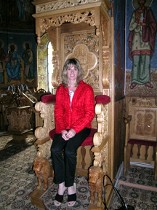 I just returned from an adventurous week in Arad, Romania, where my work was included in the first Arad Biennale. The Biennale was a collaboration between Terra dell’Arte Association (Italy), Ponte delle Arti (Italy), the Arad County Council and City Hall, and the West University of Arad. The artistic committee comprised 14 members from around the world, who put an open call out for participation, based on an initial website review. When I initially received my invitation, I wasn’t even sure where Arad was located. (It is in the western part of Romania, near Hungary in the state of Transylvania). (Image left: here’s proof that Colette found Arad.)
I just returned from an adventurous week in Arad, Romania, where my work was included in the first Arad Biennale. The Biennale was a collaboration between Terra dell’Arte Association (Italy), Ponte delle Arti (Italy), the Arad County Council and City Hall, and the West University of Arad. The artistic committee comprised 14 members from around the world, who put an open call out for participation, based on an initial website review. When I initially received my invitation, I wasn’t even sure where Arad was located. (It is in the western part of Romania, near Hungary in the state of Transylvania). (Image left: here’s proof that Colette found Arad.)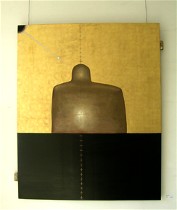 Artistic Director Alfonso Caputo had a grand mission–to create an opportunity for exchange and dialogue; a space where artists could recover the shared values of human dignity and peace, starting from the most diverse experiences, cultures, languages and religions. He chose Arad, because of its geographic location in Eastern Europe, the Romanian’s strong tradition in culture, the high concentration of artists and the receptiveness from the city government (right, image by Romanian artist Sonin Dumitrescu).
Artistic Director Alfonso Caputo had a grand mission–to create an opportunity for exchange and dialogue; a space where artists could recover the shared values of human dignity and peace, starting from the most diverse experiences, cultures, languages and religions. He chose Arad, because of its geographic location in Eastern Europe, the Romanian’s strong tradition in culture, the high concentration of artists and the receptiveness from the city government (right, image by Romanian artist Sonin Dumitrescu).The result–210 participating artists from 50 countries exhibited in four pavilions around the city. Director Caputo was especially pleased to exhibit underrepresented nations including Kosovo, Pakistan, India, Nigeria, Kuwait and Malawi.
The traveling salon
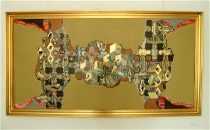 Overall, the week was a success. The real benefit to attending the festivities was the opportunity to meet and network with artists from all over the globe. Reminiscent of utopic artist salons, I spent many hours in smoky cafes speaking with artists about life, philosophy and of course art. Language was never a barrier. There were always folks eager to jump in and translate. At any given moment, people would be speaking simultaneously in Spanish, Romanian, Italian, English and Turkish. I left with new friends and promises of future international projects/invitations (left, image by Romanian artist Zamfir Dumitrescu).
Overall, the week was a success. The real benefit to attending the festivities was the opportunity to meet and network with artists from all over the globe. Reminiscent of utopic artist salons, I spent many hours in smoky cafes speaking with artists about life, philosophy and of course art. Language was never a barrier. There were always folks eager to jump in and translate. At any given moment, people would be speaking simultaneously in Spanish, Romanian, Italian, English and Turkish. I left with new friends and promises of future international projects/invitations (left, image by Romanian artist Zamfir Dumitrescu).The thumbnail verdict
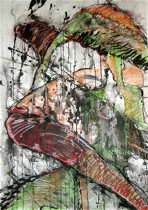 Painting predominated the Biennale. If the focus was to promote new media in contemporary art, this was a major weakness. There were only two video artists and a handful of photographers. The work was uneven and the Biennale would have been stronger with a stricter selection process from the artistic committee (right, image by Kosovo artist Artan Balaj).
Painting predominated the Biennale. If the focus was to promote new media in contemporary art, this was a major weakness. There were only two video artists and a handful of photographers. The work was uneven and the Biennale would have been stronger with a stricter selection process from the artistic committee (right, image by Kosovo artist Artan Balaj).On Wednesday, art historian, Ileana Pintilie from Timisoara University spoke about Romanian contemporary art, which included performance art, land and installation art. It was interesting to note the global parallels in contemporary art. However these trends were not in evidence in the Romanian pavilion.
The Romanian pavilion
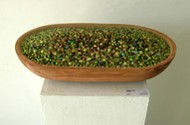 Dominated by painting and Christian iconography, many of the works were traditional. I wondered if the prevalence of religious themes had to do with the fall of communism in Romania? I was told that religion is a very important part of culture and the arts reflect these values. Highlights from this pavilion included Arad artist Onisim Colta, whose intricately layered sculptures embrace Biblical themes in a subtle and complex manner. He works with non-traditional materials such as cardboard, treating them with the precision and reverence of a precious material. Technically the works are superbly crafted, and inspire awe within the ordinary (left, a piece by Colta).
Dominated by painting and Christian iconography, many of the works were traditional. I wondered if the prevalence of religious themes had to do with the fall of communism in Romania? I was told that religion is a very important part of culture and the arts reflect these values. Highlights from this pavilion included Arad artist Onisim Colta, whose intricately layered sculptures embrace Biblical themes in a subtle and complex manner. He works with non-traditional materials such as cardboard, treating them with the precision and reverence of a precious material. Technically the works are superbly crafted, and inspire awe within the ordinary (left, a piece by Colta).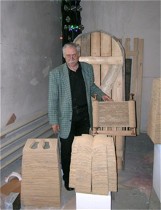 I had the opportunity to visit his studio (right) and the works there were much more interesting than the works chosen for the Biennale.
I had the opportunity to visit his studio (right) and the works there were much more interesting than the works chosen for the Biennale.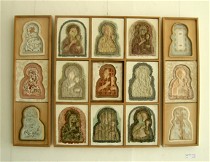 Other highlights include Arad artist Steinhubel Zoltan, who created multiple bas-reliefs of the Madonna & Child from cast paper on canvas (image, left), Bucharest artist Zamfir Dumitrescu whose painting “Arabesc” (see third image from the top) depicted religious figures interwoven with geometric cubes and locks and Bucharest artist Sonin Dumitrescu whose work “Biserica” had distinct political overtones (see second image from the top). Painted with traditional gold leaf, the work featured an imposing silhouetted figure, which could represent either the victim or the persecutor.
Other highlights include Arad artist Steinhubel Zoltan, who created multiple bas-reliefs of the Madonna & Child from cast paper on canvas (image, left), Bucharest artist Zamfir Dumitrescu whose painting “Arabesc” (see third image from the top) depicted religious figures interwoven with geometric cubes and locks and Bucharest artist Sonin Dumitrescu whose work “Biserica” had distinct political overtones (see second image from the top). Painted with traditional gold leaf, the work featured an imposing silhouetted figure, which could represent either the victim or the persecutor.
Awards and honors
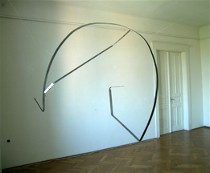 Closing night included the awards ceremony. After spending a week getting to know so many of the artists, it was thrilling to see some of my ‘new’ friends win prizes. Kosovo artist Artan Balaj (age 29) won a special award for Distinguished Young Artist . Earlier in the week, Balaj had taken on a local art critic, who stated that no one is an artist until they are 40 or 50. Balaj proved him wrong. His visceral multi-media works on paper employ aggressive mark making, which metaphorically reference his experiences in war-torn Kosovo (see fourth image from the top; image right is Paula Rubio’s “Universacion”).
Closing night included the awards ceremony. After spending a week getting to know so many of the artists, it was thrilling to see some of my ‘new’ friends win prizes. Kosovo artist Artan Balaj (age 29) won a special award for Distinguished Young Artist . Earlier in the week, Balaj had taken on a local art critic, who stated that no one is an artist until they are 40 or 50. Balaj proved him wrong. His visceral multi-media works on paper employ aggressive mark making, which metaphorically reference his experiences in war-torn Kosovo (see fourth image from the top; image right is Paula Rubio’s “Universacion”).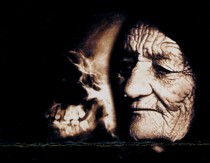 First prize in photography went to Turkish photographer (and Doctor) Sefa Ulukan, whose work represents life, death and beauty. The compelling color photographs blend x-ray images with the body and environment (left, a photo by Ulukan).
First prize in photography went to Turkish photographer (and Doctor) Sefa Ulukan, whose work represents life, death and beauty. The compelling color photographs blend x-ray images with the body and environment (left, a photo by Ulukan).Paula Rubio from Chile won the first prize in Sculpure for the minimalist work entitled “Universacion” (above right), and Spanish artist Ernst Kraft won Painting’s first prize.
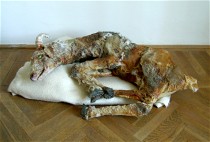 In Mixed Media, Canadian artist Jennifer Macklem won for her work “A Goat’s Tale: Narcissus and 3 Sequences” (right). The piece included four framed prints and two sculptures. The goat sculpture looked flayed, with its textured skin raw and sinewy.
In Mixed Media, Canadian artist Jennifer Macklem won for her work “A Goat’s Tale: Narcissus and 3 Sequences” (right). The piece included four framed prints and two sculptures. The goat sculpture looked flayed, with its textured skin raw and sinewy.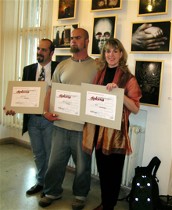
There were other special prizes given, including one for yours truly. My award was for Distinguished Artistic Achievement and Dedication to Education. (That’s Colette with fellow honorees Ulukan at left, and Balaj in center.)
–Video artist Colette Copeland teaches at the University of Pennsylvania and at the University of the Arts









